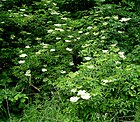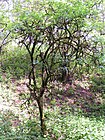Note: This is a project under development. The articles on this wiki are just being initiated and broadly incomplete. You can Help creating new pages.
Difference between revisions of "Sambucus nigra - Elderberry"
(→Mode of Propagation) |
(→External Links) |
||
| Line 89: | Line 89: | ||
[[Category:Herbs]] | [[Category:Herbs]] | ||
| + | [[Category:Ayurvedic herbs that don't have flower, fruit and leaf photos]] | ||
| + | [[Category:Ayurvedic herbs that don't have seed photos]] | ||
Revision as of 15:27, 16 May 2019
Sambucus nigra is a species complex of flowering plants in the family Adoxaceae and it is native to most of Europe and North America.
Contents
- 1 Uses
- 2 Parts Used
- 3 Chemical Composition
- 4 Common names
- 5 Properties
- 6 Habit
- 7 Identification
- 8 List of Ayurvedic medicine in which the herb is used
- 9 Where to get the saplings
- 10 Mode of Propagation
- 11 How to plant/cultivate
- 12 Commonly seen growing in areas
- 13 Photo Gallery
- 14 References
- 15 External Links
Uses
sinus infection, cold and flu symptoms., blood sugar, Ease Allergies, Skin eruptions, diabetes, Cancer, acne, skin rashes
Parts Used
Chemical Composition
Elder flower contains flavonoids (up to 3%) composed mainly of flavonol glycosides (astragalin, hyperoside, isoquercitrin, and rutin up to 1.9%) and free aglycones (quercetin and kaempferol); minerals (8?%), mainly potassium[1]
Common names
| Language | Common name |
|---|---|
| Kannada | |
| Hindi | |
| Malayalam | |
| Tamil | |
| Telugu | |
| Marathi | NA |
| Gujarathi | NA |
| Punjabi | NA |
| Kashmiri | NA |
| Sanskrit | |
| English | Elderberry |
Properties
Reference: Dravya - Substance, Rasa - Taste, Guna - Qualities, Veerya - Potency, Vipaka - Post-digesion effect, Karma - Pharmacological activity, Prabhava - Therepeutics.
Dravya
Rasa
Tikta (Bitter), Kashaya (Astringent)
Guna
Laghu (Light), Ruksha (Dry), Tikshna (Sharp)
Veerya
Ushna (Hot)
Vipaka
Katu (Pungent)
Karma
Kapha, Vata
Prabhava
Habit
Identification
Leaf
| Kind | Shape | Feature |
|---|---|---|
| Simple | Alternate | The leaves are made up of two or more discrete leaflets |
Flower
| Type | Size | Color and composition | Stamen | More information |
|---|---|---|---|---|
| Unisexual | 2-4cm long | Yellow | 5-20 | Flowers Season is June - August |
Fruit
| Type | Size | Mass | Appearance | Seeds | More information |
|---|---|---|---|---|---|
| General | 7–10 mm | The fruit is fleshy | many | {{{6}}} |
Other features
List of Ayurvedic medicine in which the herb is used
- Vishatinduka Taila as root juice extract
Where to get the saplings
Mode of Propagation
How to plant/cultivate
Landscape Uses:Border, Container, Massing, Pollard, Standard, Seashore, Specimen. A very easily grown plant, it tolerates most soils and situations[3]
Commonly seen growing in areas
Wet and dry fertile soils, Primarily in sunny locations, Borders of forests and fields.
Photo Gallery
References
External Links
- Ayurvedic Herbs known to be helpful to treat sinus infection
- Ayurvedic Herbs known to be helpful to treat cold and flu symptoms.
- Ayurvedic Herbs known to be helpful to treat blood sugar
- Ayurvedic Herbs known to be helpful to treat Ease Allergies
- Ayurvedic Herbs known to be helpful to treat Skin eruptions
- Ayurvedic Herbs known to be helpful to treat diabetes
- Ayurvedic Herbs known to be helpful to treat Cancer
- Ayurvedic Herbs known to be helpful to treat acne
- Ayurvedic Herbs known to be helpful to treat skin rashes
- Herbs with Fruits used in medicine
- Herbs with Flowers used in medicine
- Herbs with common name in English
- Habit - Shrub
- Index of Plants which can be propagated by Seeds
- Herbs that are commonly seen in the region of Wet and dry fertile soils
- Herbs that are commonly seen in the region of Primarily in sunny locations
- Herbs that are commonly seen in the region of Borders of forests and fields
- Herbs
- Ayurvedic herbs that don't have flower, fruit and leaf photos
- Ayurvedic herbs that don't have seed photos








